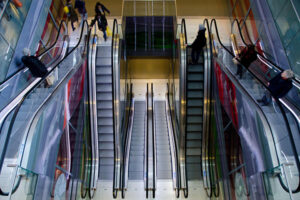The turnover of online stores in Europe and the USA is growing massively. Just recently, the US Department of Commerce released the latest figures for the last quarter of 2015. The unsurprising result: While e-commerce sales grew by 15.1% over the same period the previous year, retail turnover overall increased only by a modest 1.6%. This is astounding, considering the fact that consumers usually mostly express a preference for shopping in physical stores in relevant surveys. The specific reason they cite is the ability immediately to see and touch products. After all, people like to know what they’re buying. It is nevertheless apparent that brick-and-mortar stores cannot keep up with the rapid growth of online retail. There are already numerous ways retailers can significantly enhance the attractiveness of their retail spaces, provide additional services, and ultimately benefit themselves by means of new retail technologies, however. What trends and technologies are retailers already working with at the point of sale?
Interactive dressing rooms
The US fashion company Ralph Lauren has taken a promising path. It recently installed interactive dressing rooms in its store on New York’s Fifth Avenue. The so-called Oak Fitting Room was developed by the tech start-up Oak Labs and has a mirror that can be operated easily via touch screen. Among other things, customers can order other sizes, virtually view additional outfits that match the selected pieces, or simply use the touch screen to call an employee for advice. Ralph Lauren plans to expand use of the concept. Interactive dressing rooms were originally developed by eBay to allow a personalized experience for customers and to integrate online formats into physical stores. The number of merchants that use this technology—particularly exclusive retail formats—is now growing rapidly.
Beacons
So-called “beacons” are a technology that could revolutionize communication between retailers and consumers. Beacons are small transmitters with a big impact: They link the point of sale with the digital world. Beacons are a Bluetooth-based communication technology (Bluetooth Low Energy). While shopping at designated spots, they send information to the merchant app on a customer’s smartphone. Retailers can thus inform customers about promotions, competitions, and useful details about products with great precision.
Interactive shop windows
Shop windows have always been an effective means of directing customers into a store. Making them digital or interactive enhances the effect of a shop window on multiple levels. Customers can get an overview of a particular product or the variety of goods in the store without ever entering it. Even a direct purchase at the storefront is technically possible today. It’s ideal for customers who know what they want and don’t want to stand in line at the check-out. Virtual shop windows are often used in high-priced retail segments, in particular.
Heat mapping technology
This technology mainly benefits retailers. It makes it possible for retailers to get to know their customers better using in-store video footage and other visual analysis technologies. It helps in the analysis of customer behavior, in particular, and provides information on where, why, and how long customers linger in a certain place, which products and product groups they head for first, and more. With targeted analysis, retailers are able to steer shopping, entertainment, and customer experience processes. Furthermore, since many stores already have viable security and video technology, the investment costs are quite manageable.






